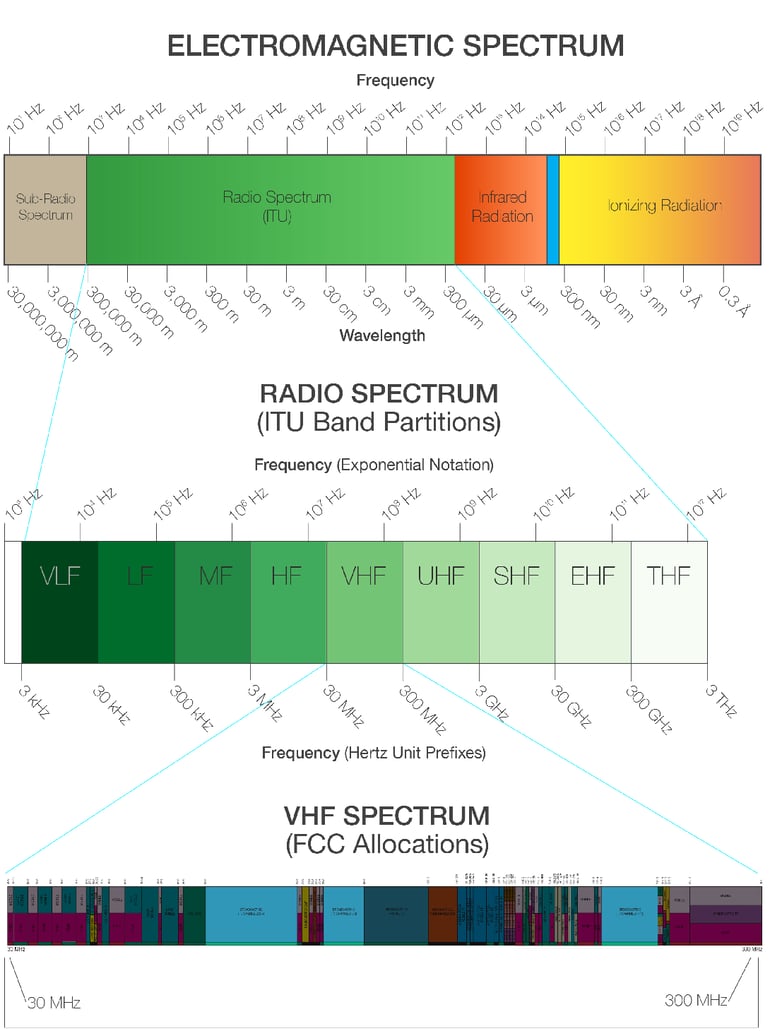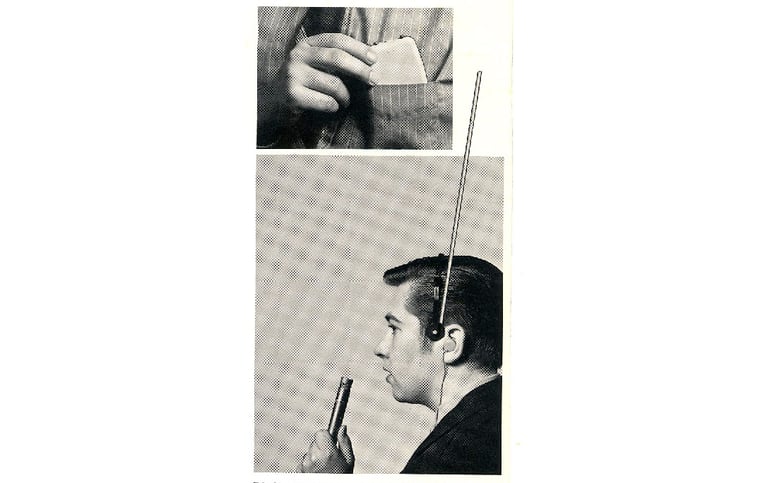
Last week Lectrosonics announced the release of the IFB-VHF, a 174-216 MHz tuned version of their popular IFB-UHF system.
(Which, by the way, has nothing to do with, and does not look like, the vintage marketing image from the old manufacturer Vega, shown above, and plenty more here.)
Of the new product, Lectrosonics President Karl Winkler said: “By adding the IFB system on the VHF frequencies, it allows users and system designers to move these out of the critical UHF band, which should improve the ability to coordinate larger systems even in a crowded RF environment.”
Lectrosonics is one of the first—but certainly not the last— major wireless audio manufacturers to reintroduce products in the VHF (30-300 MHz) band in an effort to ease the RF congestion at every large-scale production in UHF, and get a running start on the incentive auction’s decimation of 40-50% or more of current UHF spectrum available.
So far, these early second wave VHF devices are all non-performance devices—devices that wirelessly transmit some sort of audio or control that is not heard by the audience. (I say second wave because wireless audio began in VHF, and then migrated up to UHF in the mid to late 90s.) The only other major player to go VHF has been Radio Active Designs, with their successful UV-1G intercom system. There are no wireless microphones or monitors yet in VHF, though we might see some drop down to VHF sooner or later.
The announcement from Lectrosonics last week has got us thinking about VHF in general.
How suitable is it to performance and non-performance wireless audio gear?
What are the benefits of VHF over UHF?
And, crucially, if those benefits exist, can we expect them to last?
[NOTE: This discussion is mostly relevant to the United States and VHF spectrum in the US. Other regions may have different VHF allocations.
What is VHF?
“VHF” is defined by the ITU as radio waves between 30 MHz to 300 MHz. Go ahead and get yourself oriented with this supersized spectrum map.

Wireless audio users are not allowed free range across all 270 MHz that VHF theoretically offers. We are confined to empty VHF broadcast band DTV channels.
In a location where there are no VHF DTV channels, there are 76 MHz of spectrum available.
I want to repeat that. In the best case scenario VHF offers only 76 MHz of spectrum. By comparison, UHF currently offers 220 MHz, and 2.4 GHz around 86 MHz.
The VHF TV broadcast band is also non-contiguous; it is split into three bands (the highlighted blue bars in the chart above) containing 16 DTV channels separated by other services. “Low band” VHF, “mid band” VHF, and “high band” VHF. Low band extends from 54-72 MHz, mid band from 76-88, and high band from 174-216 MHz. Because the separation between low and mid band is so small (only 4 MHz) some lump both low and mid band VHF into simply “low band VHF” and call it 54-88 MHz.
The Pros of VHF
-
Lower Traffic
At the moment, VHF has fewer devices and fewer TV stations in it than UHF. During the DTV transition, many TV stations migrated up to UHF, abandoning VHF due to concerns over interference. Every major wireless audio manufacturer abandoned VHF by the mid 90s, so aside from RAD, Lectrosonics, and a few other products you might encounter on a production, like Comtek IFBs, VHF is a veritable oasis of solitude for low power wireless audio devices like wireless microphones and in-ear monitors. This is the main draw to VHF, and make no mistake: it’s a big one. -
Better Range
Because of the propagation characteristics of VHF frequencies, signals are able to carry farther with the same amount of transmission energy than they are at UHF. Well-designed VHF equipment, operating with the same transmitter power, under the same conditions, and the same gain antenna, will travel farther than a UHF signal. -
Less In-Line Attenuation
The generosity of VHF propagation extends into coaxial cables, too. You get much less in-line attenuation (signal loss inside cable) with VHF equipment than you do with UHF, which means you can do longer coaxial cable runs with fewer or no amplifiers, and use less expensive types of cable and expect the same performance.
Cons of VHF
-
Larger Antennas & Components
This is probably the biggest hangup. Because VHF frequencies have longer wavelengths, the devices themselves tend to be larger, heavier, and more expensive if they are engineered to the same quality standards as current-day UHF gear. For example, the wavelength of 180 MHz is about 5.5’. Whereas a 550 MHz signal has a wavelength of only 1.8’.Because of the long wavelengths of low band VHF (54-88 MHz), it’s unlikely that we’ll see much, if any, performance equipment manufactured there at all. Designing the antennas and electronics for a flawlessly reliable wireless microphone or in-ear for low band VHF are practically impossible without resorting to some wacky, expensive, and aesthetically unappealing tricks.

Non-performance equipment, like IFBs and intercoms however can use low-band VHF, since the audio quality of the audio feed is less critical. Comtek already offers a few products in that range.
-
Incentive Auction Uncertainty
There are still TV stations that use VHF frequencies. Most of them are public access or low power TV stations. But others may return.One of the “incentives” built into the incentive auctions is the option for a broadcaster to swap their UHF license for a VHF license and still get a payout. How many broadcasters will bite on that worm is yet to be seen. It’s possible that an uncertain number of current UHF stations will take the bait and move down to VHF, further crowding what is (remember) only 76 MHz.
-
Low Power Pig Pile
If all wireless audio manufacturers suddenly started making lots of gear in VHF, we’d have a problem.As James Stoffo once told me, “VHF is like that bar that used to be crowded, but now no one goes to anymore. There’s nothing wrong with the bar—it’s just that people have the perception that it was crowded, so they don’t go there anymore.”
If people (manufacturers) started going to the VHF bar again in droves, it would get crowded. And it would get crowded a lot faster than it took to crowd up UHF, because of its relatively small size.
It might be argued the pig pile problem has happened in the last 1-2 years at 2.4 GHz. Since 2013, just about every major manufacturer has rolled out a 2.4 GHz band microphone.
The result?
It is very difficult to use multiple channels of 2.4 GHz microphones in any realistic venue. If you only need one 2.4 Gig mic—you’re fine. But need four, eight, or 12 channels of 2.4 wireless? Don’t look to tech support to solve that problem, look to religion; the 2.4 GHz ISM band is simply too utilized, even without adding a spectrum hogging microphone to the mix. WiFi and bluetooth devices use 2.4 GHz spectrum, too, and their use has exploded at 2.4 GHz even more than wireless audio.
-
Higher Noise Floor
In most locations, the noise floor at VHF is slightly higher than it is at UHF. The difference, though, is small. And the noise floor in a large-scale production is always going to be elevated.
IS VHF the Answer?
VHF is not “the” answer to wireless audio’s impending spectrum shortage. But it is one of several answers that, combined, will lead us out of the darkness ahead.
Future regulatory and technological seismic shifts will not allow us to keep all of our equipment exclusively in UHF for much longer.
Instead, the numerous low power wireless devices used in large-scale productions will have to fan out across the spectrum in combination with the correct deployment of tools like external antennas, filtration, and new modulation schemes if we are to continue to use them in the same quantities.
There is almost no other alternative.
Luckily, we’ve got RF options. We have VHF, we have the unlicensed bands at 900 MHz, 1.9 GHz, and 2.4 GHz, as well as (debatably) 5.8 GHz. There are plenty of additional bands open to holders of Part 74 and Part 90 licensees, as well as new bands that are slated to open to license holders post-auction, including the 169–172 MHz band, the 944–952 MHz band, the 941– 944 MHz and 952–960 MHz bands, the 1435–1525 MHz band, and the 6875–7125 MHz band. More on those here.
We won’t be kissing UHF goodbye, at least not yet. We’ll just be saying hello to unfamiliar spectrum elsewhere, making wireless production band-planning far more fragmented, but still doable.


